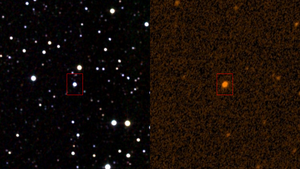KIC 8462852
| Observation data Epoch J2000.0 Equinox J2000.0 (ICRS) |
|
|---|---|
| Constellation | Cygnus |
| Right ascension | 20h 06m 15.457s |
| Declination | +44° 27′ 24.61″ |
| Apparent magnitude (V) | +11.705±0.017 |
| Characteristics | |
| Evolutionary stage | Main sequence |
| Spectral type | F3V |
| B−V color index | 0.557 |
| V−R color index | 0.349 |
| R−I color index | 0.305 |
| J−H color index | 0.212 |
| J−K color index | 0.264 |
| Astrometry | |
| Proper motion (μ) |
RA: −9.9±2.6 mas/yr Dec.: −10.5±2.4 mas/yr |
| Parallax (π) | 2.555 ± 0.311mas |
| Distance |
1276.6+398.2 −245.3 ly (391.4+122.1 −75.2 pc) |
| Absolute magnitude (MV) | 3.08 |
| Details | |
| Mass | 1.43 M☉ |
| Radius | 1.58 R☉ |
| Luminosity (bolometric) | 4.68 L☉ |
| Surface gravity (log g) | 4.0±0.2 cgs |
| Temperature | 6750±120 K |
| Metallicity | 0.0±0.1 |
| Rotation | 0.8797±0.0001 days |
| Rotational velocity (v sin i) | 84±4 km/s |
| Other designations | |
| Database references | |
| SIMBAD | data |
| KIC | data |
KIC 8462852 (also Tabby's Star or WTF Star) is an F-type main-sequence star located in the constellation Cygnus approximately 1,276.6+398.2
−245.3 light-years (391.4+122.1
−75.2 pc) from Earth. Unusual light fluctuations of the star were discovered by citizen scientists as part of the Planet Hunters project, and in September 2015 astronomers and citizen scientists associated with the project posted a preprint of a paper on arXiv describing the data and possible interpretations. The discovery was made from data collected by the Kepler space telescope, which observes changes in the brightness of distant stars to detect exoplanets.
Several hypotheses have been proposed to explain the star's large irregular changes in brightness as measured by its unusual light curve, but none have fully explained all aspects of the curve. The leading hypothesis, based on a lack of observed infrared light, posits a swarm of cold, dusty comet fragments in a highly eccentric orbit. Another hypothesis is that of a large number of small masses in "tight formation" orbiting the star. It has been speculated that the changes in brightness could be signs of activity associated with intelligent extraterrestrial life constructing a Dyson swarm. The SETI Institute's initial radio reconnaissance of KIC 8462852, however, found no evidence of technology-related radio signals from the star.
...
Wikipedia

